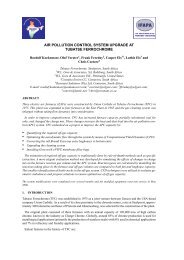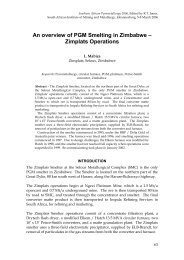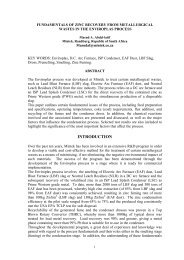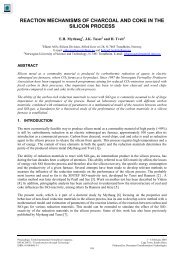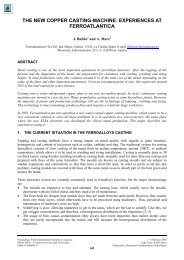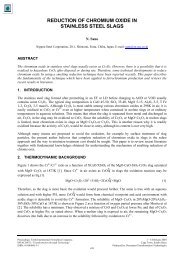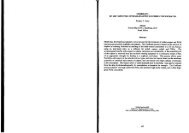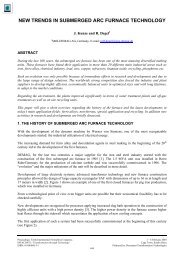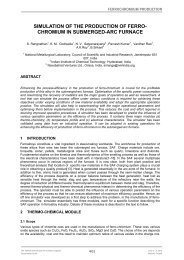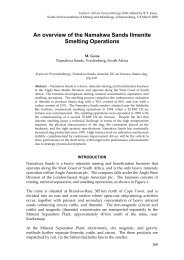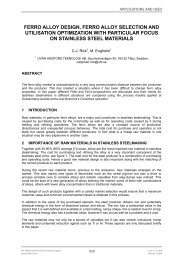Create successful ePaper yourself
Turn your PDF publications into a flip-book with our unique Google optimized e-Paper software.
Ferromanganese Smelting4.2.3 Summary of the HCFeMn campaign using a DC current power supplyFor the HCFeMn submerged-arc smelting campaign with DC current, the necessary busbar changeswere made. The furnace dome and shell after the clean-out that followed the AC FeMn test remainedin the same position. Only the roof with three apertures for the graphite electrodes was replaced withone that contained only two apertures for the twin-cathode electrodes.The DC sub-arc campaign for smelting HC FeMn started with Tap 25. The feed blend with the start-upwas the same as was used in the AC FeMn test, but a change was made in the percentage reductantwith the start of Tap 28 – the total reductant was reduced by approximately 10% from 26.9 kg per 100kg manganese ore to 23.8 kg per 100 kg manganese ore. The reason for the change was that a lot ofcarbonaceous material had been found in the material removed during the digout after the AC FeMntest. However, to be able to compare the AC and DC submerged-arc smelting of HCFeMn on thesame basis, the raw material blend was changed back to 26.9 kg total reductant per 100 kgmanganese ore from Tap 41 to the end of the DC test.A statistical summary of the electrical operating data is given in Table 6. Subsequent to the warm-uptap [i.e. from Tap 26 onwards] the average instantaneous power input from the two drives was about134 kW and tapping operations were attempted after an average of 361 kWh of energy input [averagetap-to-tap “power on” time of 2.7 hours], giving about 204 kWh of energy when lost energy issubtracted based on average heat losses (based on conduction through refractory lining only) ofabout 55 kW over an average total tap-to-tap time of 2.8 hours. The net effect was that, as with theAC HCFeMn test, the average quantity of alloy per tapping operation was about 63 kg.Several electrode-to-hearth determinations were done with the numerical average of eightmeasurements [4 per electrode] being 183 mm.4.2.4 Summary of the SiMn campaign using a DC current power supplyThe DC submerged-arc smelting campaign commenced using the same recipes used in the ACsubmerged-arc test for SiMn. The only difference was that the recipe with the larger amount of highMn/Fe ore was used in the first part [Taps 1 to 26] and the recipe with equal amounts of the twomanganese ore types in the smelting blend was used during the latter part of the test [Taps 27 to 48].Most of the tapping operations were markedly more difficult during this test as compared to the SiMnsmelting campaign using the AC setup. This is born out by an iron balance subsequent to the test thatshows that on average 5.2 kg of lance rod was used per tapping operation in the DC submerged-arcSiMn test as compared to 3.5 kg in the AC submerged-arc SiMn test. The dilution effect on the alloywas compounded by the fact that the average quantity of molten material tapped in the DC test[average total amount [slag + alloy (corrected for iron pick-up from lancing)] was about 65 kg [25 kgalloy], compared to approximately106 kg [40 kg alloy] in the AC test.The furnace control philosophy was based on current setpoint as was the case with the HCFeMnsubmerged arc campaign. The current setpoint was initially 2000 A per drive, up to Tap 8, after whichit was changed to 2500 A per drive, in order to get better stability with respect to power input. Table 6summarizes electrical parameters, specifically averages and standard deviations of Tap averages ofthe parameters E1, E2, V1, V2, P1, P2, and total power.The average heat losses [by conduction through furnace refractory] totaled 65 kW – these lossesincreased during the course of the campaign with an average of 60 kW for the first part and 72 kW forthe second part. After the warm-up batch [Tap 1], i.e. from Tap 2 onwards, the average energy inputbetween tapping operations was of the order of 329 kWh at an average instantaneous power level ofaround 142 kW, giving an average tap-to-tap “power on” duration of 2.3 hours. With an average totaltap-to-tap time of 2.7 hours [average downtime of 0.4 hours per tap] the effective average energy pertapping operation was around 152 kWh, compared to 232 kWh for the AC submerged-arc SiMncampaign. The ratio of these values for the effective average energy per tapping operation is of thesame order of the ratio of average molten material tapped per tapping operation between the twocampaigns.The Twelfth International Ferroalloys CongressSustainable Future502June 6 – 9, 2010Helsinki, Finland



